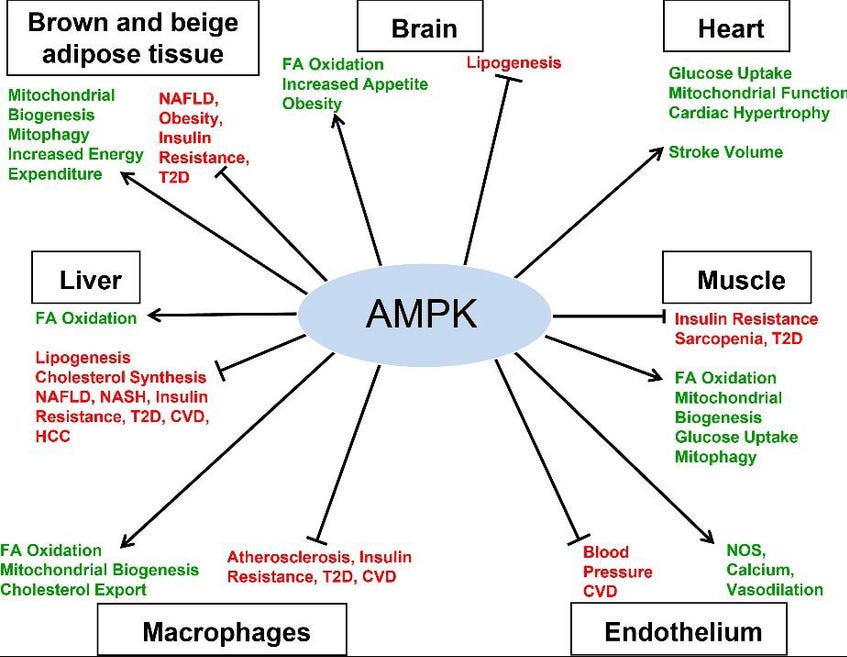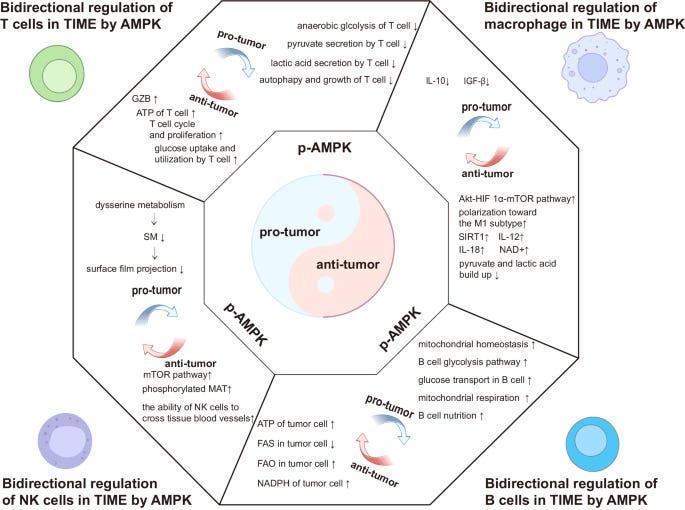In a recent article, I discussed how some popular drugs for controlling weight or blood glucose can fool our body into releasing more insulin or curbing our appetite. But are there natural alternatives to these drugs?
Every drug and food works on several biochemical (molecular) pathways in the body so no two drugs or foods are identical or completely equivalent in their effect on our metabolism of energy. Yet, one of the important metabolic pathways activated by drugs like Metformin, i.e., AMPK, can also be activated in natural ways.
Metformin and AMPK
Metformin is known to promote a pathway in the body called AMPK (AMP-activated Protein Kinase). Here we go with scientific and then simple explanations of AMPK:
AMPK, is a crucial enzyme that acts as a cellular energy sensor, activating when energy levels are low and inhibiting energy-consuming processes to restore balance. It stimulates glucose and fatty acid uptake and oxidation to produce energy while suppressing processes like protein and lipid synthesis.
Simplified Science: Our cellular energy centers (mitochondria) always need to have enough energy as reserve/storage (in the form of ATP, Adenosine triphosphate, molecules) so cells constantly decide on whether they have enough ATP to build (to rejuvenate and to make more protein or fat cells), or not enough, in which case they will bring in more glucose or even burn some fat cells and stop making new cells. In my books I call this latter mode the Break Down (catabolic) mode. The problem with Type II diabetes (or prediabetic condition) is the resistance of cells to insulin, the hormone in the blood that signals the cells to bring in more glucose. So sugar level in the blood rises. Drugs like Metformin inhibit/disrupt mitochondria, and prompt the cell (temporarily) to sense ATP “deficiency” and switch to a catabolic mode which is also activated by AMPK, allowing more glucose in and even burning some stored fat. Such cells are fooled (biohacked/programmed) to ignore their resistance to insulin.
In summary, by disrupting/inhibiting Mitochondrial Complex I of the respiratory chain, Metformin can:
1- Stimulate release of GLP-1 (signaled by unmetabolized glucose in intestines) and insulin.
2- Amplify AMPK and Suppress cellular growth
3- Trigger calcium release from the endoplasmic reticulum (ER), mitochondrial stress (swelling), fragmentation and programmed cell death (apoptosis)
Potential Risks and Problems
In my mind, the root of “insulin resistance” is the metabolic mismatch between the body’s downstream energy (ATP) “needs” (over time) and the available fuel (glucose, fat) circulating upstream (in the blood).
The problem with this pharmaceutical biohack is that on the one hand we are disrupting the synthesis of ATP inside the cell’s energy production unit (mitochondria), and on the other hand we are taking up more glucose and fat molecules (fuel) into the cell. It is like choking an inefficient (plugged up or dirty) engine with more fuel (gasoline). This is why Metformin indirectly promotes the formation of lactates and can lead to the serious side effect of lactic acidosis (see recent article The Serious Risks Associated with Metformin and Ozempic).
In fact, Metformin can impair exercise performance in athletes who need excellent mitochondrial functions and are already risking acidosis (due to hypoxic muscles during strenuous activities). Metformin is shown to have a negative impact on the increase in skeletal muscle mass and strength caused by progressive resistance exercise training.
Because of its artificial effect on GLP-1 and appetite control through manipulating intestinal metabolism of nutrients, Metformin type drugs are associated with nausea and serious digestive disorders in some individuals.
Besides insulin resistance and metabolic acidosis, long-term use of metformin is associated with vitamin B12 deficiency, fatigue, anemia, and neurological issues.
Interestingly, disorders such as hypoxia and smoking (through nicotine) also activate AMPK. Nicotine is linked to insulin resistance because of its effect on AMPK. In fact, people (quitting smoking) who suffer from nicotine withdrawal symptoms feel relieved after using Metformin because Metformin also activates AMPK!
Drugs like Metformin are also known to suppress the mTOR1 pathway, which “anabolically” works to balance AMPK, by allowing ATP expenditures for cellular proliferation and growth.
Although boosting AMPK is helpful for certain Diabetic and cancer patients, chronic activation of this pathway leads to reduced protein synthesis, cell proliferation, and neurogenesis, and contributes to negative outcomes like depression, cognitive decline, stunted growth, reduced muscular and bone strength.
Also, Metformin can trigger the release of calcium from the endoplasmic reticulum (ER) in some cell types, a process linked to ER and mitochondrial stress (swelling) and fragmentation, which can lead to a key mechanism in the process of apoptosis (programmed cell death). While this effect of Metformin can be helpful in suppressing cancer cells, it can also lead to mitochondrial dysfunctions, and death/degeneration of healthy cells.
Natural Ways to Upregulate AMPK and Suppress mTOR
Quercetin (as in onions, berries, and apples) often activates AMPK, which contributes to neuroprotective effects in diabetic patients and increased apoptosis (programmed cell death) and the inhibition of cell proliferation in cancer patients.
Curcumin, the active compound in turmeric, is also known to activate AMPK, particularly when used with black pepper and gently heated in the presence of oil/fat (curcumin is fat soluble). As a result, turmeric (the organic, pure kind from reliable sources) shows anti tumor and anti-diabetic properties. Curcumin/turmeric activate a hormetic response in the cell. In low concentrations, they can scavenge reactive oxygen species and reduce mitochondrial damage, but in high concentrations, they impair energy production and mitochondrial health by decreasing mitochondrial membrane potential and oxidative phosphorylation.
Hesperidin, the bioactive compound in organic citrus fruits, particularly in the albedo (the white pulp) is known to activate AMPK pathway and offers benefits such as preventing fatty liver, inhibiting the creation of fat cells (adipogenesis), promoting fat breakdown (lipolysis) and insulin sensitivity (lower blood sugar) and improving intestinal tight junctions. Unlike Metformin, Hesperidin is not a mitochondrial disruptor.
Resveratrol, found in the skin of darker grapes, blueberries and cranberries, can also activate AMPK, but similar to curcumin (in turmeric), can also be a mitochondrial inhibitor in larger doses.
Salicylate (found in aspirin), is found in many fruits and vegetables. Salicylates act as a key stress signal in plants, triggering defense mechanisms against biotic threats (like pathogens and insects) and abiotic stressors (such as cold, drought, and heavy metals). Salicylate is a mitochondrial inhibitor and as such, activator of AMPK, like Metformin.
Hunger (Signaling the brain through Ghrelin, a hormone released in an empty stomach, as explained in my books or my other article Another Tragic Story About Ozempic) and other sources of stress, such as exercise, can activate AMPK pathway to conserve energy in times of energy shortage/needs. Chronic stress, however, leads to reduced protein synthesis, cell proliferation, and neurogenesis, which contributes to negative outcomes like depression, cognitive decline, stunted growth, muscular or bone strength.
As discussed above, disorders such as hypoxia and smoking (through nicotine) can also activate AMPK. Hypoxia, like other stressors, can increase mitochondrial reactive oxygen species, and therefore, intracellular calcium levels. Nicotine is linked to insulin resistance because of its effect on AMPK. . In fact, people (quitting smoking) who suffer from nicotine withdrawal symptoms feel relieved after using Metformin because Metformin also activates AMPK.
Other Dangers Associated with Chronic Activation of AMPK
The systemic activation of AMPK is not without risks, and several potential side effects and deleterious outcomes have been noted:
- Tumor-Promoting Effects in Certain Contexts:
Although AMPK is generally considered a metabolic tumor suppressor, emerging evidence suggests that its activation can have opposite effects under certain conditions. In some stages of tumor development, AMPK activation may be used by cancer cells as a survival mechanism to adapt to metabolic stress, thereby promoting malignant conversion and metastasis.
- Cardiac Hypertrophy and Glycogen Accumulation:
Chronic activation of AMPK, especially through indiscriminate pan-activation, has been associated with cardiac hypertrophy. This is particularly problematic when activating AMPK complexes that include certain isoforms (e.g., γ2) that are abundant in the heart. Mutations in these subunits have been linked with glycogen storage diseases and hypertrophic cardiomyopathy.
- Unintended Effects on Appetite Regulation:
Activation of AMPK in the hypothalamus, while beneficial for energy sensing, has been reported to increase feeding behavior and body weight gain in some settings, potentially counteracting the metabolic benefits observed in peripheral tissues.
- Inflammatory and Immune System Modulation:
The immune regulatory roles of AMPK are subtle and context-dependent. While AMPK activation can suppress pro-inflammatory responses in macrophages, there is evidence that its activation in other immune contexts may impair immune cell function or lead to unwanted immunosuppression.
- Off-target Effects of Indirect Activators:
Many well-known AMPK activators, such as metformin or natural products like resveratrol and berberine, exert their effects indirectly by altering mitochondrial function. This mechanism can lead to a broad spectrum of off-target effects that are not solely attributable to AMPK activation. For example, mitochondrial inhibition may adversely affect tissues that rely heavily on oxidative metabolism.
mTOR (mechanistic or mammalian target of rapamycin) is a protein that acts as a central regulator of cell growth, proliferation, and survival by responding to signals from nutrients (especially animal-based amino acids and proteins), hormones (like insulin), and growth factors. When chronically-activated (by hormones like insulin), mTOR activity can contribute to cancer development (uncontrolled cellular growth).




Metformin appears to activate the Vitamin D Receptor (more D to kidney cells, etc,) - March 2025
https://vitamindwiki.com/tiki-index.php?page_id=15877
which includes
Metformin fights COVID (Metformin $121, Vitamin D $10 per life saved)
Thank you for sharing - so important to know!